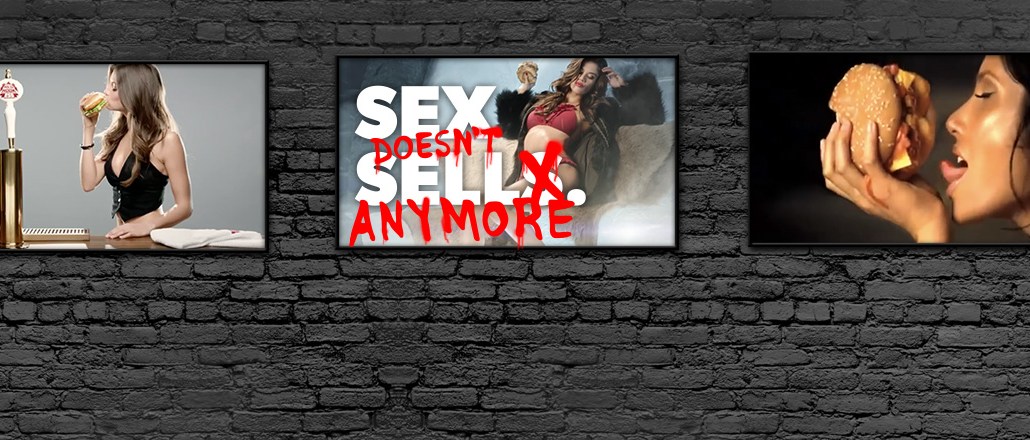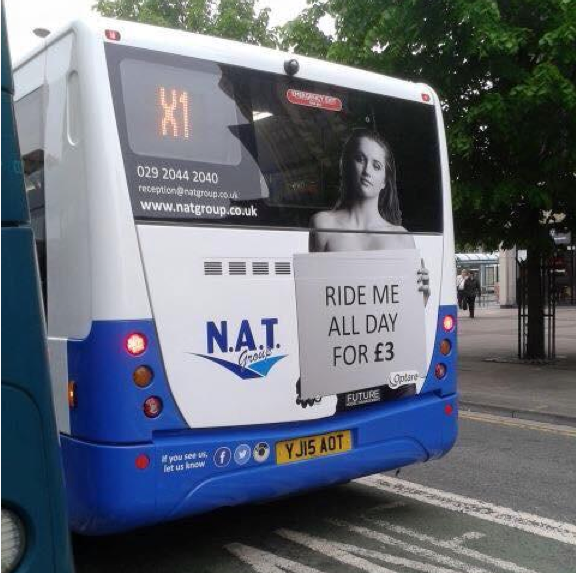Save 50% on a 3-month Digiday+ membership. Ends Dec 5.

Mark Duffy has written the Copyranter blog for 10 years and is a freelancing copywriter with 20-plus years of experience. His hockey wrist shot is better than yours. Follow him on Twitter.
What gives, 18-34-year-olds? Why don’t you like sexy ads? You don’t like hot-bod come-ons, Kate Upton milk baths, bikini babes biting big burgers? What are you millennials, Puritans?
Even though you’re taught in ad school that “there are no rules in advertising,” there are rules in advertising: respect the white space, nobody reads body copy, account people are assholes, and T&A = ROI.
Sexy “sexist” ads have been in the ad news lately. Last week, a Cardiff bus company felt compelled to pull a mildly racy campaign that promoted all-day tickets because of some negative feedback. My only negative feedback for the campaign is that it should have been all nude men, since, technically sexually speaking, they are the ones who are ridden.

Earlier this year, another sexy “sexist” ad, a U.K. TV spot for “the world’s slimmest phone” featuring a slim woman in underwear, was banned for objectifying women and because the ad’s “content bore no relationship to the advertised product.”
Ad position: web_incontent_pos1
What? Slim woman = slim phone, maybe? My criticism of the ad is with the hackneyed creative execution: an overused motif of black-and-white spot-and-color product, no drama, lame music, etc.
Here in the States, we don’t ban an ad because three people complained about it being too sexy. Right now, the most bluntly “sexy” major campaign running is via Carl’s Jr./Hardee’s. It started about 10 years ago, with Paris Hilton fake-eating a burger in a car wash during the Super Bowl. Since then, unapologetic CEO Andy Puzder — through L.A. ad agency 72andSunny — has paraded scantily clad Kim Kardashian, Kate Upton, Padma Lakshmi (that is, Miss Turkey advertising his turkey burger, hardy har har), and other lesser-known bodies across your TV and device screens pretending to eat his fast food.

For several years, these concept-less ads have apparently worked, increasing both chains’ sales. But this year, the (millennial male) consumers have apparently finally figured out that any bikini models that happen reside in their hometowns don’t want to have lunch with them at Hardee’s/Carl’s Jr.
Ad position: web_incontent_pos2
A recent report by Ameritest, one of the industry’s leading advertising testing firms, found that sex actually doesn’t sell and really doesn’t sell for Mr. Puzder.
Sean Scott, Ameritest senior brand consultant, told Ad Age that sex just “doesn’t perform that well in spurring purchase intent.” In particular, the report took a close look at one of Carl Jr.’s latest ads, its 2015 Super Bowl “all-natural” burger commercial featuring model Charlotte McKinney and her bouncing “natural” boobs.
While the video has over 11 million views, Scott says the ad performed well below average in purchase intent. A third (32 percent) of the viewers surveyed felt worse about Carl’s Jr. after seeing the ad, compared to 8 percent who felt that way after seeing other fast-food brand ads. Ouch.
The report hasn’t stopped Puzder from rolling out his soft porn spots including this video featuring Victoria’s Secret model Sara Sampaio trying to bite a burger as big as her head.
But the main problem with the Hardee’s/Carl’s Jr. ads — and really with every “sexy” spot currently running — isn’t the sex; it’s the stupidity. The models are attached to the ads as an afterthought; they’re not integral to a selling concept. These spots should be getting blistered for sucking, not for sexism. Besides, these days one can find — if one desires — several videos of attractive women sans bikinis eating burgers. (I’m not linking to those).
Don’t fret, people who still like sex. Sex can sell. You just have to put some thought into it.
More in Marketing

Ulta, Best Buy and Adidas dominate AI holiday shopping mentions
The brands that are seeing the biggest boost from this shift in consumer behavior are some of the biggest retailers.

U.K. retailer Boots leads brand efforts to invest in ad creative’s data layer
For media dollars to make an impact, brands need ad creative that actually hits. More CMOs are investing in pre- and post-flight measurement.

‘AI is permeating everything we do’: How Guitar Center developed 2 AI tools this year
This summer, the company launched a chatbot called Rig Advisor to help customers find the right instruments and products.
Ad position: web_bfu
